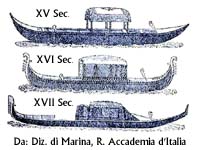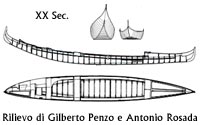The gondola is the World most famous Venetian boat. The etymology of its name is uncertain, it could be a portmanteau word between the verb dondolare (to rock gently) and the Middle Age Greek kondura, short-tailed boat - ancient gondolas, indeed, had a less soaring stern than today┤s ones - or maybe from Latin cunula, rocking crib.
Many sumptuary laws were promulgated from time to time by the Republic of Venice to limit the waste in luxury, as the nobles and merchants were obliged to provide financial support for the war ventures and the architectonic renewals of the Serenissima. Some of these Laws were concerned with gondola┤s hangings, but it seems that the strict imposition of the black colour was originated from a State Votive Offering, pronounced in the circumstances of one of the terrible plagues, which, periodically, were decimating the Population.
The rules of building a gondola are very strict, they impose asymmetrical calculations for the two sides (lai), a length of 10,75 meters and internal width of 1,38 meters.
There is a version, called gondola da tragheto (Ferry-Gondola), larger and less hogged, used to transport of 15/20 passengers from one side to the other of the Grand Canal, in the few stassi (ferry) left over to day.
The aspect of today┤s gondolas is much different from the one that can be seen in the pictures of the ┤700┤s Venetian painters. Then, indeed, the gondolas were not asymmetric nor with a high stern, as they were always rowed by two gondoliers.
Those gondolas were having a long and flat stem, to make easier the boarding and disembarking of the passengers, when the town was mostly lacking in masonry banks and landing stages.
 Becoming more and more a status symbol boat, the gondola modified also the foredeck, the fiuboni, which became cuspidal and enriched with all sorts of carved, inlayed and gilded ornaments.
Becoming more and more a status symbol boat, the gondola modified also the foredeck, the fiuboni, which became cuspidal and enriched with all sorts of carved, inlayed and gilded ornaments.
To allow an easier manoeuvring of the gondola by a lone oarsman, the asymmetry and the raising of the stern were implemented.
 The gondola indeed is a boat that is still in evolution: its sesto, that is the rule which sets the scalar ratio between the frames in its shape, is frequently updated, mainly to allow the craft to face the rise of the waves caused by engine boats.
The gondola indeed is a boat that is still in evolution: its sesto, that is the rule which sets the scalar ratio between the frames in its shape, is frequently updated, mainly to allow the craft to face the rise of the waves caused by engine boats.
By tradition, the gondola is made up of 280 parts, executed in eight different kinds of wood: larch, fir, oak, elm, cherry, mahogany, linden and walnut; today, however, is more and more rife to see it built with marine plywood.
 The lone metal parts, besides the parecio (removable iron and brass ornaments) are the stern and the bow irons.
The lone metal parts, besides the parecio (removable iron and brass ornaments) are the stern and the bow irons.
The bow one is called dolfin (dolphin) because of the resemblance with the muzzle of the dolphins and its shape changed across the centuries too; in the upper part it recalls the Corno del Dose (Horn of the Duke, the headgear used instead of a crown), in the shank the meandering of the Grand Canal, in the comb the city┤s Sestieri (districts in number of six) and the Giudecca (in the opposing tooth), while the decorated points between tooth and tooth represent the main Islands of the Lagoon.
 The stern iron is called risso (ringlet) because of the convoluted shape that might remember the moving of the oar, and became smaller and smaller across the centuries.
The stern iron is called risso (ringlet) because of the convoluted shape that might remember the moving of the oar, and became smaller and smaller across the centuries.
The gondolas are now only used for people transport and for the regattas.
See also: Dodesona, Quatordesona, Disdotona and Gondolino